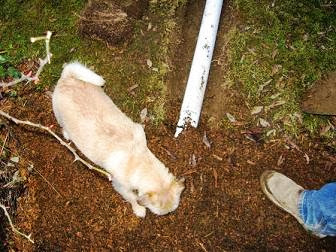This post is about adapting a pet door intended for installation in a person door to an outside wall.
Having reached full size, Harley’s cat door was getting tight at his chest so I decided to upgrade to this medium dog door. The door was intended for installation in a person door, but I chose to install it in an outside wall instead. Locating the door was the first challenge. For the original door, I considered the height outside and came up with a way for the animals to travel at the same level on the outside. I chose to put one side of the door adjacent to a stud. Small holes drilled though the walls helped confirm the measurements before cutting the house. This new door just required scaling up the original.
Lowes had a cedar lumber scrap pile in the warehouse that yielded a broken 2x4, damaged lap siding, and inside the store, I located a broken 1x2 cedar furring strip. This brought the cost of the cedar down to a fraction of the undamaged cedar, and there were plenty of good parts of the wood to cut up to frame the pet door.
Abby checking out the project.
The pet door was designed for the two halves to screw together and hold themselves to the person door. For this stud wall adaptation onto lap siding, a frame seemed a suitable substitute to provide a flat and plumb surface for mounting the outer pet door. The new cedar siding helped fill irregularities to make the outer lap siding surface somewhat flat.
Cedar siding filling in sides where the frame will go.
The new lap siding also provided adjustment for plumb. Here the frame is moved up until the level shows the frame is plumb.
The frame was leveled and plumbed before fastening.
Frame attached to the wall.
Rough opening from the inside.
A hand drywall saw was used for cut outs and trimming.
Extra pieces of the new lap siding helped fill in the larger remaining openings.
2x4 cedar was cut and fit around the three unframed sides of the opening, then the boards were screwed together. The bottom had two lengths of 2x4 to build up the height.
These products were used to fill gaps and seal exterior seams.
Exterior spackle closed the larger gaps.
Kilz primer was applied to the raw finishes and for future outside painting.
A box helped keep the cold air out.
A heater sped the drying.
½-inch stainless steel screws attached the outer pet door to the frame.
Sanded grout was used to level, fill, provide good traction, and waterproof the walking surface of the pet door.
A little Elmer’s glue and caulk were used to attach the inner decorative flange.
Pet door ready to use. ~Chuck

























































